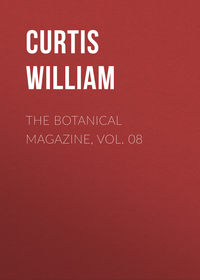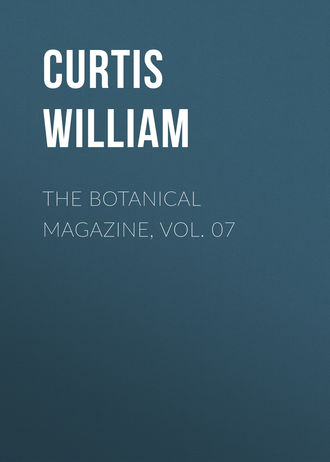 полная версия
полная версияThe Botanical Magazine, Vol. 07
Mr. Masson, who is employed to collect plants at the Cape, for the Royal Garden at Kew, and in which employment he so honourably acquits himself, as the Hortus Kewensis bears ample testimony, sent hither seeds of this Pelargonium, which flowered in that matchless collection in the year 1792; a few plants of it have also been raised from Cape seeds, by Mr. Williams, Nurseryman, at Hammersmith, some of which flowered this spring with Mr. Colvill, Nurseryman, Kings-Road.
It must be several years before the lovers of plants can be generally gratified with the possession of this plant, most of its branches running out speedily into flowering stalks, form few proper for cuttings, which are struck with difficulty, and perfect seeds are sparingly produced.
It appears to be equally hardy as most others of the same tribe, and to require a similar treatment.
[241]
Fagonia Cretica. Cretian Fagonia
Class and OrderDecandria MonogyniaGeneric CharacterCal. 5-phyllus. Petala 5, cordata. Caps. 5-locularis, 10-valvisi, loculis 1-spermis.
Specific Character and SynonymsFAGONIA cretica spinosa, foliolis lanceolatis planis lævibus. Linn. Sp. Pl. ed 3. p. 553. Mant. p. 380. Linn. Syst. Vegetab. ed. 14. Murr. p. 401. Ait. Kew. v. 1. p. 62.
TRIFOLIUM spinosum Creticum. Clus. Hist. 2. p. 242. f. Bauh. Pin. p. 330.
FAGONIA cretica spinosa. Tourn. Inst. p. 265.
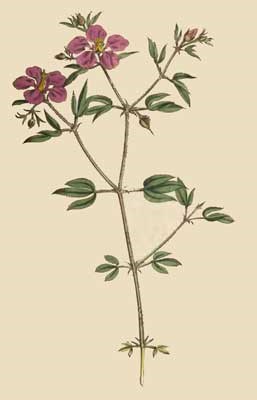
No241.
Clusius is the first author who has described and figured this plant, he is very minute in his description of it, noticing the exact number of its stamina; it is the more surprising, therefore, that he should have so little idea of generic character, as to rank it with the trefoils merely from the form of its leaves: Tournefort, born to illustrate the genera of plants, named it Fagonia in honour of his friend and patron, Mons. Fagon, privy counsellor and consulting physician to Lewis XIV
This species is a native of the island of Candia, and was cultivated here by Mr. Miller, in 1739; it is an annual, and as it does not perfect its seeds with us in the open air, unless in very favourable seasons, it is usually treated as a green-house plant, its seeds should be sown in the autumn, as it thereby flowers earlier, and ripe seeds are with more certainty obtained.
It blossoms from June to August.
The plant from which our drawing was made, flowered this season in the very rich collection of Messrs. Lee and Kennedy, Hammersmith.
Its branches are usually procumbent, about a foot in length, and require, if the plant be kept in a pot, to be tied up to a stick.
[242]
Veronica Decussata. Cross-Leav'd Speedwell
Class and OrderDiandria MonogyniaGeneric CharacterCor. limbo 4-partito: lacinia infima angustiore. Caps. 2-locularis apice emarginata.
Specific Character and SynonymsVERONICA decussata spicis terminalibus paniculatis, foliis oblongis integerrimis lævigatis coriaceis, caule fruticoso. Ait. Kew. v. 1. p. 20.
VERONICA decussata floribus racemosis axillaribus, foliis ovalibus decussatis integerrimis. Moench. Weissenstein. p. 137. Linn. Syst. Nat. tom. 2. ed. 13. Gmel. p. 30.

No242.
The plant here represented, is a native of Falkland's Island, and was introduced to this country by Dr. Fothergill, about the year 1776; if permitted to grow, it will become a bushy shrub of a considerable size: it has been chiefly admired for the unusual and regular growth of its leaves, which are ever-green, and grow thickly on the branches, cross-wise, affording an excellent example of the folia decussata; but it is entitled to our admiration on another account, its blossoms have a most delicious fragrance (similar to that of the Olea fragrans) not mentioned by authors, and we believe scarcely known, having never heard it spoken of by those who have cultivated the plant; its flowers, which are white, are produced on the tops of the branches, which, however, they do not strictly terminate, but usually grow out just below the summits, on short racemi; the corolla is sometimes divided into five segments, and there is a greater equality in the segments than is usually found in the flowers of the Veronica, the seed-vessel differs also in its form, being longer, more oval, and scarcely emarginate; these several deviations from the structure of the Veronica genus, joined to the fragrance of the blossoms of this plant, induce us to think, that it has more affinity with the Olea above mentioned.
Cultivators complain, that it does not blow freely; without any peculiarity of treatment, it flowers with us every year, about the middle of June; it is one of the more hardy greenhouse plants, which is usually and readily increased by cuttings.
[243]
Argemone Mexicana. Mexican Argemone, or Prickly Poppy
Class and OrderPolyandria MonogyniaGeneric CharacterCor. 6-petala. Cal. 3-phyllus. Caps. semivalvis.
Specific Character and SynonymsARGEMONE mexicana capsulis sexvalvibus, foliis spinosis. Linn. Syst. Vegetab. ed. 14. Murr. p. 490. Ait. Kew. v. 2. p. 225.
PAPAVER spinosum. Clus. Hist. 2. p. 93.
CARDUUS chrysanthemus Peruanus. The Golden Thistle of Peru. Ger. Herb. p. 993.
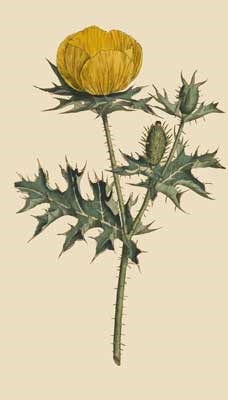
No243.
This species of Argemone is a native of Mexico, and the West-Indies, where we should suppose it to be a very common and noxious weed, from the name there given it of Fico del inferno, or the Devil's Fig: it has long been introduced to this country; Gerard, who cultivated it with success, ludicrously attributes its nickname to a different source: "The golden Thistle of Peru, called in the West-Indies, Fique del inferno, a friend of mine brought it unto me from an iland there, called Saint Johns Iland, among other seedes, what reason the inhabitants there have to call it so it is unto me unknown, unless it be bicause of his fruite, which doth much resemble a figge in shape and bignesse, but so full of sharpe and venemous prickles, that whosoever had one of them in his throte, doubtless less it would send him packing either to heaven or to hell."
Miller mentions it as a plant of no great use or beauty, in the latter point of view Clusius, who was one of the first to figure and describe it, and Gerard, thought differently; its foliage is certainly beautiful, somewhat like that of the milk thistle, its blossoms are large and shewy, though not of long duration; like the Celandine, the whole plant abounds with a yellow juice, which flows out when it is wounded; it differs from the poppy, to which it is nearly related, in having a calyx of three leaves.
Though a native of a very warm climate, it is cultivated with as much facility as any annual whatever; in the gardens about London, where it has once grown, and scattered its seeds, it comes up spontaneously every spring, flowers in July and August, and ripens its seeds in September; these are large, somewhat round, of a black colour, with a beautiful surface; a light rich soil and warm situation suits it best.
[244]
Ipomœa Quamoclit. Winged Leav'd Ipomœa
Class and OrderPentandria MonogyniaGeneric CharacterCorolla infundibuliformis. Stigma capitato-globosum. Caps. 3-locularis.
Specific Character and SynonymsIPOMŒA Quamoclit foliis pinnatifidis linearibus, floribus subsolitariis. Linn, Syst. Vegetab. ed. 14. Murr. p. 204. Ait. Kew. v. 1. p. 215.
QUAMOCLIT s Jasminum Americanum. Clus. Posth. 9.
CONVOLVULUS tenuifolius Americanus. The red Bellflower of America. Park. Parad. p. 358. 3.
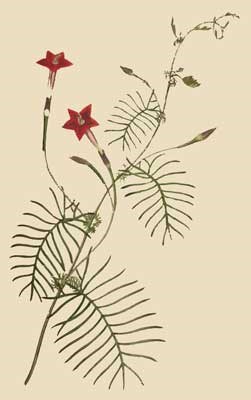
No244.
In a former number of this work, we gave a figure of the Scarlet Ipomœa, which every one possessing a garden, at least in the more southern parts of this kingdom, might gratify themselves with a sight of, it being hardy enough to flower and ripen its seeds in the open border; but the present species, an annual also, and equally beautiful, with greater singularity of foliage, can be brought to perfection only in the stove of hot-house.
Its seeds should be sown early in the spring, two or three in a small pot; when the plants are so far advanced as to shew a disposition to climb, they should be removed with a ball of earth into a middle-sized pot, in which one, two, or three sticks, four or five feet high should be stuck, for the plants to climb up; in the months of June and July they will flower, and ripe seed will be produced in September.
This elegant species, a native of both the Indies, was cultivated here by Parkinson, who minutely describes it in his Parad terr. when speaking of the seed, he observes, "with us it will seldom come to flower, because our cold nights and frosts come so soone, before it cannot have comfort enough of the sun to ripen it."
[245]
Teucrium Latifolium. Broad-Leav'd Shrubby Germander
Class and OrderDidynamia GymnospermiaGeneric CharacterCor. labium superius (nullum) ultra basin 2-partitum, divaricatum ubi stamina.
Specific Character and SynonymsTEUCRIUM latifolium foliis integerrimis rhombeis acutis villosis subtus tomentosis. Linn. Syst. Vegetab. ed. 14. Murr. p. 526. Ait. Kew. v. 2. p. 276.
TEUCRIUM fruticans bæticum ampliore folio. Dill. Elth. 379. t. 284. f. 367.
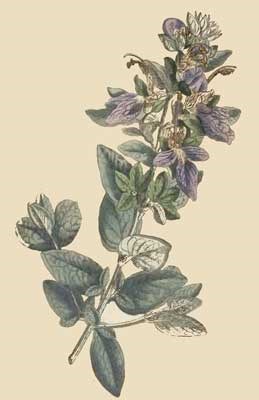
No245.
The Teucrium latifolium as well as the fruticans, which is nearly related to it, is a native of Spain, and was cultivated in this country in 1714, by the Duchess of Beaufort, vid. Ait. Kew.
It is a shrubby plant, growing to the height of seven or eight feet (it may be trained to a much greater height) now common in our greenhouses, and sometimes planted in the open border in warm situations, where it will bear about the same degree of cold as the myrtle; it flowers during most of the summer months, and is readily increased by cuttings.
[246]
Aquilegia Canadensis. Canadian Columbine
Class and OrderPolyandria PentagyniaGeneric CharacterCal. 0. Petala 5. Nectaria 5 corniculata, inter petala. Caps. 5 distinctæ.
Specific Character and SynonymsAQUILEGIA canadensis nectariis rectis, staminibus corolla longioribus. Linn. Syst. Veg. ed. 14. Murr. p. 535. Ait. Kew. v. 2. p. 248.
AQUILEGIA pumila praæox canadensis. Corn. Canad. 60.
AQUILEGIA præcox canadensis; flore externe rubicundo, medio luteo. Moris. Hist. 111. p. 457. t. 2. f. 4.
AQUILEGIA Virginiania flore rubescente præcox.
The early red Columbine of Virginia. Park. Th. p. 1367.
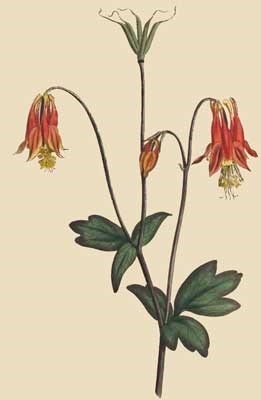
No246.
Parkinson was not acquainted with this plant when he wrote his Parad. terr. but in his larger and more general work, the Theat. Pl. published in 1640, he describes and figures it as a plant newly introduced from Virginia, by Mr. John Tradescant: Cornutus, in his account of the plants of Canada, gives us a representation and a description of this plant also; according to him, its usual height in that country is about nine inches; in the gardens here it nearly equals the common Columbine, which it considerably resembles in the appearance of its foliage, but differs in the form and colour of its flowers, the horn of the nectary is straighter, and the blossom in some of its parts inclines more to orange, which renders it highly ornamental.
It is a hardy perennial, and may be easily propagated by parting its roots in autumn or spring; it may also be raised from seeds, which ripen readily here; these are found to be a long time in vegetating, as are others of this genus.
We have observed in some gardens, a Columbine of more humble growth than the one here figured, called by the name of canadensis, and which most probably is a variety of our plant, its blossoms spread wider, are of a pale red colour without any orange, and hence being less beautiful, is, of course, less worthy of culture.
[247]
Scabiosa Atropurpurea. Sweet Scabious
Class and OrderTetrandria MonogyniaGeneric CharacterCal. communis polyphyllus; proprius duplex, superus. Recept. paleaceum nudum.
Specific Character and SynonymsSCABIOSA atropurpurea corollulis quinquefidis radiantibus, foliis dissectis, receptaculis florum subulatis. Linn. Syst. Vegetab. ed. 14. Murr. p. 145. Ait. Kew. v. i. p. 137.
SCABIOSA peregrina rubra capite oblongo. Bauh. Pin. 270.
SCABIOSA vi. indica. Clus. Hist. 2. p. 3.
Red flowered Indian Scabious. Park. Parad. 324.

No247.
It is not a little singular that we should have no certain account of what country this species of Scabious is a native; Clusius who describes and figures it accurately, relates that he received seeds of it from Italy, under the name of Indian Scabious; he informs us also that he received seeds of a Scabious from Spain, which the same year produced flowers of a similar colour, but paler; Parkinson says this plant is verily thought to grow naturally in Spain and Italy; does he borrow this idea from what Clusius has advanced? he certainly gives no authority for his supposition: Linnæus mentions it as a native of India with a note of doubt; Miller does the same, omitting any doubts about it; Mr. Aiton leaves its place of growth unsettled.
The Sweet Scabious has long and deservedly held a place as an ornamental plant in our gardens, the flowers are well adapted for nosegays, have a sweet musky smell, and are produced in great profusion from June to October.
It is a hardy biennial, requiring yearly to be raised from seeds, these should be sown about the latter end of May, or beginning of June, on a shady border of fresh earth, thinning the plants as they advance to the distance of three or four inches; in autumn they should be removed into the border, where they are intended to flower, thus treated they will become good strong plants against winter, flower early the ensuing summer, and produce abundance of perfect seeds.
The blossoms vary in colour, towards autumn the edge of the florets become paler.
Parkinson, deviating from his usual accuracy, describes the flowers without scent. vid. Parad.
[248]
Vinca Rosea. Madagascar Periwinkle
Class and OrderPentandria MonogyniaGeneric CharacterContorta. Folliculi 2 erecti. Semina nuda.
Specific Character and SynonymsVINCA rosea caule fructescente erecto, foliis ovato oblongis, petiolis basi bidentatis, floribus geminis sessilibus. Linn. Syst. Vegetab. ed. 14. Murr. p. 252. Ait. Kew. v. 1. p. 296.
VINCA foliis oblongo-ovatis integerrimis, tubo floris longissimo, caule ramoso fruticoso. Mill. Icon. 86.
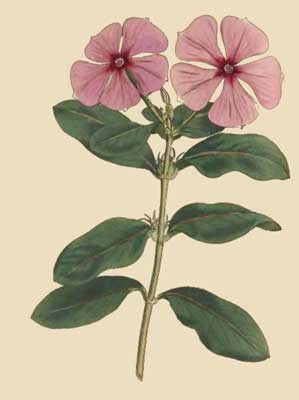
No248.
The Vinca rosea was first Cultivated in this country by Mr. Philip Miller in 1757, he observes that it deserves a place in the stove as much as any of the exotic plants we have in England, because the flowers are very beautiful, and there is a constant succession of them all the summer.
The following account is extracted from his Dictionary.
"This plant grows naturally in the Island of Madagascar, from whence the seeds were brought to the Royal Garden at Paris, where the plants were first raised, and produced their flowers the following summer; from these plants good seeds were obtained, which were sent me by Mr. Richard, gardener to the King at Versailles and Trianon. It rises to the height of three or four feet; the branches which when young are succulent become ligneous by age: these flowers which appear early in the summer produce ripe seeds in the autumn.
"This sort is propagated by seeds or cuttings in the usual way; unless the summer proves warm these plants should not be placed abroad, for they will not thrive if they are exposed to cold or wet, therefore during the summer they should be placed in an airy glass-case, and in winter they must be removed into the stove, where the air is kept to a temperate heat, without which they will not live through the winter in England. Mill. Dict.
There is a variety of this plant having white blossoms with a purple eye.
The flowers do not always grow in pairs.
[249]
Cineraria Amelloides. Blue-Flowered Cineraria or Cape Aster
Class and OrderSyngenesia Polygamia SuperfloaGeneric CharacterRecept. nullum. Pappus simplex. Cal. simplex polyphyllus æqualis.
Specific Character and SynonymsCINERARIA Amelloides pedunculis unifloris, foliis oppositis ovatis nudis, caule suffruticoso. Linn. Syst. Vegetab. ed. 14. Murr. p. 765. Ait Kew. v. 3. p. 219.
ASTER africanus frutescens ramosus, floribus cæruleis, foliis oppositis minimis, caulibus et ramulis in pedunculos nudos exeuntibus. Raii Suppl. 158.
ASTER caule ramoso scabro perenni, foliis ovatis sessilibus, pedunculis nudis unifloris. Mill. Icon. 76. f. 2.
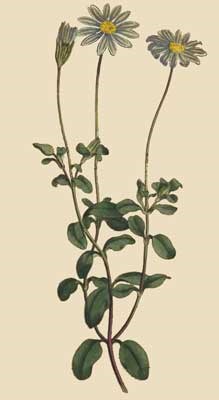
No249.
The Cineraria Amelloides a plant common in every green-house, was introduced by Mr. Philip Miller as long since as the year 1753, being raised by him from Cape seeds; it forms a bushy shrub, of the height of two, or three feet, produces numerous blossoms, which stand singly on long footstalks, are of a pale blue colour; they make some amends for their want of brilliancy by flowering during most of the year.
The plant is easily propagated either by seeds or cuttings.
[250]
Myrtus Tomentosa. Woolly-leaved Myrtle
Class and OrderIcosandria MonogyniaGeneric CharacterCal. 5-fidus, superus. Petala 5. Bacca 2. s. 3 sperma.
Specific Character and SynonymsMYRTUS tomentosa pedunculis unifloris, foliis triplinervii, subtus tomentosis. Ait. Kew. v. 2. p. 159.
ARBOR sinensis canellæ folio minore, trinervi, prona parte villoso, fructu caryophylli aromatici majoris villis similiter obducto. Pluk. Amalth. 21. t. 372. f. 1.

No249.
In the third edition of the Species Plant. of Linnæus, published in 1764, thirteen Myrtles are described; in the 13th edition of the Syst. Natur. published by Gmelin in 91, forty-one are enumerated; thus in twenty-seven years this genus has gained an accession of twenty-eight species: most of these are natives of warm climates, and few comparatively have been introduced to this country, six species only being mentioned in the Hort. Kew. of Mr. Aiton, in that work the tomentosa here figured, not known to Linnæus or Miller is specifically described, and there Mr. Aiton informs us that it is a native of China, and was introduced by Mrs. Norman about the year 1766.
Since that period it has fallen into the hands of various cultivators, and flowered perhaps in greater perfection than it did originally at Kew; the peduncles, in the various specimens we have seen usually supporting more than one flower.
It is a shrub of great beauty, both in respect to its foliage and flowers, bearing but little similitude to the common Myrtle, if suffered to grow, acquiring the height of many feet.
Its blossoms are produced in June and July, the buds are covered with a white down, as is also the underside of the leaves, whence its name of tomentosa.
It has been customary to treat it as a stove plant, such it is considered in the Hort. Kew. there is great reason however to believe, that it is by no means tender, and that it may succeed as most of the Chinese plants do in a good greenhouse.
It is usually increased by cuttings which are struck difficulty.
[251]
Allium Descendens. Purple-Headed Garlick
Class and OrderHexandria MonogyniaGeneric CharacterCor. 6-partita, patens. Spatha multiflora. Umbella congesta. Caps. supera.
Specific Character and SynonymsALLIUM descendens caule subteretifolio umbellifero, pedunculis exterioribus brevioribus, staminibus tricuspidatis. Linn. Syst. Vegetab. ed. 14. Murr. p. 322. Ait. Kew. v. 1. p. 425.
ALLIUM staminibus alterne trifidis, foliis fistulosis, capite sphærico non bulbifero atropurpureo. Hall. All. Tab. 2. f. p. 355. xx. ii.
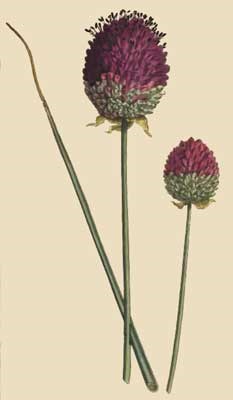
No249.
Baron Haller in his most admirable Monographia on the plants of this genus, published in his Opuscula Botanica, describes and figures this species, a hardy perennial, being a native of Switzerland, and cultivated according to Mr. Aiton, in the garden at Oxford in 1766.
It usually grows to the height of three feet, thriving in almost any soil or situation, its flowers as in many other species grow in a capitulum or little head, not an umbel, strictly speaking, as Linnæus describes it; this head is at first covered with a whitish membrane, wearing some resemblance to a night-cap, on the falling off of which the whole of the capitulum is perceived to be of a green colour, shortly the crown of it becomes of a fine reddish purple, this colour extends itself gradually downwards, presently we see the upper half of the head purple, the lower half green, in this state it has a most pleasing appearance; the purple still extending downwards, the whole head finally becomes uniformly so, and then its flowers begin to open, and emit an odour rather agreeable than otherwise; on dissecting a flower we find three of the stamina in each longer than the others, and bearing two little points, which proceed not from the antheræ, but from the top of the filaments, it is therefore one of those Alliums which Linnæus describes, as having Antheræ bicornes.
This species increases readily by offsets, which should be separated and planted in Autumn.
We know not why Linnæus should give it the name of descendens, unless from its being one of those plants whose roots in process of time descend deeply into the earth.
[252]
Campanula Grandiflora. Great-Flowered Bell-Flower
Class and OrderPentandria MonogyniaGeneric CharacterCor. campanulata fundo clauso valvis staminiferis. Stigma trifidium. Caps. insera poris lateralibus dehiscens.
Specific Character and SynonymsCAMPANULA grandiflora caule subunifloro, foliis sublanceolatis serratis, corolla patente. Jacq. in Litt. Hort. v. 3. t. 2.
CAMPANULA grandiflora foliis ternis oblongis serratis, caule unifloro, flore patulo. Linn. Suppl. p. 140. Syst. Veget. ed. 14. Murr. p. 207. Ait. Kew. v. 1. p. 218.
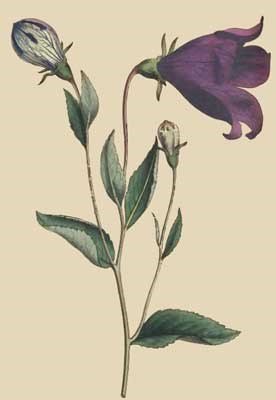
No249.


